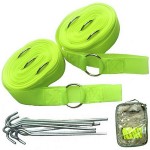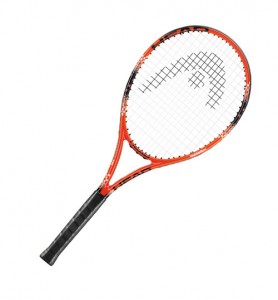Oops. This is a component part that is not sold separately.
Crossminton Easy Court Set Up

In many racquet sports, the cost of the court is a severely limiting factor. Regulation indoor badminton courts with hardwood floors, for example, cost at least $5,000 per court — and that’s only if you already have a building to put them in.
Squash and racquetball courts, on the other hand, start at about $50,000 per court while outdoor tennis courts are nearly twice that much.
Compare this to speed badminton where the cost per court is under $30.00.
That’s right!! Less than $30.00 per court.
The Oakridge Community Association in Calgary, Alberta, recently added 10 speed badminton courts to their annual racquet sports program for a cost of less than $300.00. For an additional $400.00 they also purchased all of the racquets, speeders and other accesories that will be needed to run speed badminton programs for an entire outdoor season.
The addition of these courts has allowed this non-profit community association to create added value for each annual membership sold. In addition to eight outdoor tennis courts, members of the community association will now be able to access 10 grass speed badminton courts — all of which will be overseen by existing personnel.
All the community had to do to make this happen was to get the City of Calgary’s permission to begin running speed badminton programs on an empty, underutilized, manicured green space that was adjacent to the tennis courts in Oakridge.
Easy Court Set Up
Setting up the speed badminton easy courts each day is easier than setting up a pup tent.
Each court consists of two 18′ X 18′ squares set 42 feet apart.
Each square consists of four metal rings connected to each other by four yellow nylon bands. These are fastened to the ground with thin, metal tent pegs.
Begin by staking one of the two squares needed in place with the pegs included in the Easy Court package. Then measure a distance of 42 feet directly opposite and stake out the second square.
Take care when staking out each square to stretch the bands tightly. The fabric does relax a little after set up which can cause loose lines that get moved around by the breeze. But as long as you take a few extra seconds to pull them tight during set up, this won’t be a problem.
Once the squares are in place, set up is complete. Speed badminton does not require a net, so play can begin immediately.
Each square takes about 2 minutes to set up. So it is possible to set up 10 courts in less than an hour. However, when the stakes are left in the ground overnight, set up time is cut in half.
Competitive Speed Badminton has Future

While I was off, long-time Racquet Network member, Dragan Lemez, talked me into spending some time trying out the new game of speed badminton (a.k.a. speedminton).
Since the game is played on grass over an area that is about one-quarter the size of a tennis court and since both the racquet and the speeder (shuttle) are lighter than a tennis racquet and ball, I was able to play speed badminton without aggravating the injuries that I was trying to heal during my break from tennis.
What a blast! Speed badminton is a great game with a ton of competitive potential.
Unlike other face-to-face racquet sports, there is no net in speed badminton. The playing area consists of two 18 foot by 18 foot squares set 42 feet apart.
Players must hit their speeder into their opponent’s square and prevent it from touching the ground in their own square. Points are scored whenever the speeder touches the ground.
The speed badminton racquet looks like a cross between a squash racquet and a racquetball racquet. However, it’s nearly as light as a standard badminton racquet.
The speeder looks like a miniaturized badminton shuttle tipped with a red rubber ball. It’s heavier of course, in order to allow more control and speed in typically breezy outdoor conditions. But other than that, it behaves pretty much like a standard badminton shuttle.
The game itself is reasonably fast paced. It’s not as technical as tennis nor is it as physically demanding. The fact that it is played on grass makes it much easier on the knees than hard court tennis.
The absence of a net results in many hard shots at knee level or lower that are similar to drives in squash and racquetball. As a result speed badminton incorporates more squatting and lunging than singles badminton.
Another major difference is the absence of net shots and drop shots. Without a net, of course, these standard badminton shots are not part of the speed badminton game.
In their place are deep, penetrating smashes to the back court and low, hard drives that are aimed for the front corners of an opponent’s square. These shots, combined with high clears and typical badminton defensive shots ensure that both players keep moving and keep sweating.
The only thing I didn’t like about speed badminton was the scoring system. The first time we played, we use the official scoring system: each player serves three times in succession, then the serve changes hands. The winner was the first player to 16.
The problem that we found with the official scoring system was that the games could become one-sided and uninteresting. It was especially frustrating for a player who had a bad run and found himself down by eight or nine points with the wind in his face.
It also seemed to us that the scoring system was created for indoor conditions under which neither sun nor wind are factors for either player.
We corrected this problem and made it a much more interesting game by adopting tennis scoring to speed badminton.
Each game was played to four points with the winner clear by two points. The first player to win 6 games — again clear by two — won the set. In the event of a six-all tie, we played a standard tennis tie breaker to seven points, clear by two. We also applied tennis rules to side changes.
The result was amazing. Difficulties with wind and sun were more evenly shared thanks to frequent side changes. The games were shorter and more intense with each player trying harder on every shot.
Like tennis, we found that the server won most of his service games. But unlike tennis, we were able to play a best-of-five set in just over one hour. In fact, we had enough energy left over at the end of the match to play another best-of-three match.
The only thing that prevented us from playing longer was the setting of the sun. Sadly, I did not have any of the specially designed glow-in-the-dark night speeders with me that week.
Racquet Network Joins the BBB

“This is an exciting day for the network,” said Executive Director Brent Johner in a statement yesterday. “Although we have been in voluntary compliance with their policies and ethics for nearly two years, we have not been able to display the BBB logo on our website. Now that we are officially accredited members, that will change.”
Look for the BBB logo to be displayed very prominently on the Racquet Network website over the coming days and weeks.
How Tight Should I String My Racquet?

Depending on where you take your racquets for maintenance and the quality of string you use, the price for stringing can range anywhere from $25 to $40. So restringing a racquet that cost less than $50 new is generally not a good investment.
Once that decision is made, you then have to consider the type of string you wish to use. That decision will be based on many considerations including your playing level, the number of crosses and mains on your racquet, whether or not you suffer from tennis elbow and so on.
Your stringer can help you make a decision about the kind of string you should use. Alternatively, you can use the Internet to do some research and make a decision on your own.
Finally, you arrive at the question of tension. How tight should you string your racquet?
The answer to this question depends on how you want your racquet to perform. If you want a racquet that provides stability and power, you will want to string it one way. If you want a racquet that provides touch and control, you will want to string it another way.
Every racquet has a recommended range for tension. My Wilson [K]Surge, for example, has a recommended range of 55-65 pounds. The low end of this range will create a string bed with more give. The high end of this range will create a tighter string bed.
Beginners and intermediate players who play infrequently will usually choose to string their racquets at the low end of the range because they want their strings to absorb much of the energy upon impact with the tennis ball. They also want the power that looser strings seem to offer.
Looser string beds are more forgiving than tighter string beds. So stringing their tennis racquet at the low end of the range allows players to get away with more misshits and other mistakes.
Many advanced and expert players, on the other hand, prefer a tight string bed on their tennis racquets. Players at this level have enormous control over their swing speed. They also have superior directional control and don’t make as many errors as beginner or intermediate tennis players.
For the rest of us, who are somewhere in between the beginners and the experts, the best tension is also somewhere in the middle. Find the label on your racquet indicating the recommended tension for your racquet and then instruct your stringer to string it somewhere in the middle.
[wdsm_ad id=”39760″ class=” ” ]
